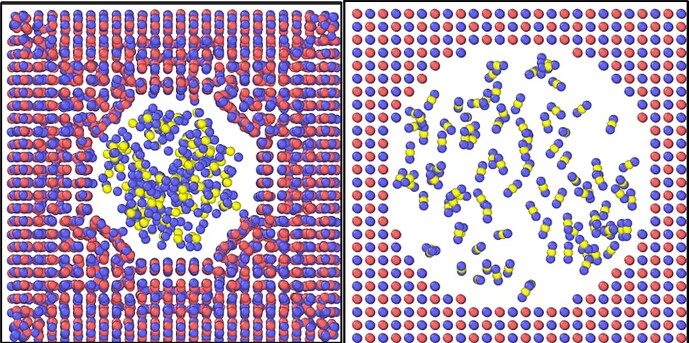“I am using LAMMPS to construct a CaO tube and fill it with CO2 molecules for NVT simulations using ReaxFF at temperatures of 873 K, 973 K, 1073 K, 1173 K, and 1273 K. However, during the simulation at 873 K, the CaO rapidly aggregates, which is not what I expected as I intend to calculate the diffusion rate of CO2. I tried using fix setforce to fix the tube, but the CaO still aggregates under the fix NVT conditions. Since I want to maintain a consistent system temperature, I am asking how to write the code to prevent CaO from aggregating. Also, do I necessarily need to perform a minimization operation? Below are images of the minimized and directly run structures.”
from your image, it seems like CaO is melting, not “aggregating”
May be that’s simply because the melting temperature of CaO as describe by your model is lower than 873 K, and therefore what you observe is just normal ? Where are your expectations coming from?
I’m not sure how any result would be chemically meaningful besides the formation of chalk.
And look carefully at your carbon dioxide. In your simulation it is dissociating into carbon and oxygen atoms. But carbon dioxide at 1000K has a formation enthalpy of about -800 kJ/mol and formation Gibbs energy of about -600 kJ/mol (otherwise how could anything burn into carbon dioxide?). So whatever it is you are hoping to model, your ReaxFF parameters do not capture.
Thank you for your response. Since I plan to add water later to observe the diffusion coefficients of CO2 and water in the CaO tube, I would like to ask whether I should fix the CaO tube in place.
Thank you for your response. Since I plan to add water later to observe the diffusion coefficients of CO2 and water in the CaO tube, I would like to ask whether I should fix the CaO tube. However, my question is how to fix it while still allowing the system to run under the NVT ensemble.
I don’t quite understand how a model that spontaneously reconstitutes molecular oxygen from carbon dioxide at 900K will be physically or chemically meaningful.
Since I don’t quite understand what you are modelling, I am not sure how you can better model it either.
You can maintain the atoms from the wall in place by not including them in a fix that update the atom positions. However, as pointed by @srtee, your system has other issues.
My guess is that reaxff is not the right force field for what you want to do.

